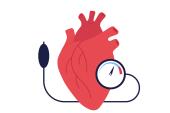More Mortality Reduction Signals With Implantable Hemodynamic Monitors in HFrEF: Meta-analysis
Going forward, data from these kinds of studies could increasingly be used by AI to help personalize therapy for HF patients, an editorial suggests.

In patients with heart failure with reduced ejection fraction (HFrEF) and a prior HF hospitalization or elevated natriuretic peptides, implantable hemodynamic monitoring (IHM) devices can significantly lower the risk of both mortality and HF hospitalization, according to a meta-analysis of three randomized controlled trials.
Looking at patient-level data from the CHAMPION and GUIDE-HF trials, which involved the CardioMEMS device (Abbott) implanted in the distal pulmonary artery, and LAPTOP-HF, which involved the investigational HeartPOD LAP sensor (Abbott), which was never commercialized, implanted in the interatrial septum, the researchers found that the impact on HF hospitalizations occurred early in the first year of monitoring, while the mortality benefits occurred after the first year.
“This is the first real suggestion that managing patients by monitoring pulmonary artery pressures improves mortality in heart failure with reduced ejection fraction,” JoAnn Lindenfeld, MD (Vanderbilt University Medical Center, Nashville, TN), the study’s lead author, told TCTMD. “It does appear that it takes longer than a year to begin to see mortality differences.”
It’s unclear what, precisely, is driving the mortality reduction, she added.
“We know that patients who have heart failure hospitalizations have higher mortality. But I think the question we don't know is: is that because it's a reflection of the higher pressures or is there something about the hospitalization itself? I think most of us think probably that the hospitalizations are reflective of the underlying problem, and that's why they have a higher mortality,” Lindenfeld noted.
That being said, she added that there are likely two distinct types of patients.
“There are probably patients whose pressures are too high most of the time and if we bring those down, you can improve their long-term outcome. There may be other patients for whom they have an actual progression of their disease that's separate from the high pressures, and those patients may still have a poor outcome because their disease is progressing,” she explained.
“The question that's really exciting here is [whether] keeping pressures lower long term is reflected not only in reduced heart failure hospitalizations but also an improvement in outcomes, not because you don't have hospitalizations, but because you have maintained low pressures and put less stress on the heart.”
The study, which builds on results first reported by TCTMD last year at the Technology and Heart Failure Therapeutics (THT) 2023 meeting, were published in the Journal of the American College of Cardiology. As TCTMD noted last year, all of the studies included in the analysis had flaws that limit any over-interpretation of the combined data: CHAMPION and GUIDE-HF were single-blinded studies, whereas LAPTOP-HF was never published, having been stopped early due to an increase in adverse events.
This is the first real suggestion that managing patients by monitoring pulmonary artery pressures improves mortality in heart failure with reduced ejection fraction. JoAnn Lindenfeld
In an accompanying editorial, Marat Fudim, MD, MHS (Duke University Medical Center, Durham, NC), and colleagues write that IHM therapy is still in the early stages, with many of its benefits still unclear. Work is still needed, they argue, to understand the optimal IHM-guided management strategy and how it should be incorporated into routine clinical practice.
“The real-world benefits of IHMs will likely improve with increasing experience as individual sites become more familiar with the technology and progressively refine algorithms that better align with specific patient populations, team members, and practice workflow,” they write.
Meta-analysis Findings
The pooled patient-level meta-analysis of 1,350 patients (mean age 63.5; 25% female; 25% Black) included 12-month follow-up for GUIDE-HF and 24-month follow-up for CHAMPION and LAPTOP-HF. Patients in each study were randomized to the device group or a control group receiving standard of care.
At 12 months, the reduction in HF hospitalization for the device versus placebo groups was roughly similar in all three studies: GUIDE-HF (HR 0.71; 95% CI 0.53-0.96), CHAMPION (HR 0.69; 95% CI 0.53-0.89), and LAPTOP-HF (HR 0.52; 95% CI 0.38-0.71). When pooled, this translated to a 36% relative reduction in HF hospitalization (P < 0.0001).
Looking at mortality, while GUIDE-HF did not show a mortality advantage for the device group, CHAMPION and LAPTOP-HF showed similar mortality curves with increased separation between the treatment and control groups after approximately 12 months of follow-up through 2 years. The mortality reduction with CHAMPION came with a hazard ratio of 0.67 (95% CI 0.44-1.00), with an even stronger reduction in LAPTOP-HF (HR 0.56; 95% CI 0.34-0.93). When pooled, this translated to a 25% relative reduction in mortality (P = 0.043).
In a supplemental analysis with the addition of GUIDE-HF follow-up during COVID-19 and the LAPTOP-HF participants who were randomized but not implanted, the extent of the mortality reduction was similar to what was observed in the main analysis (HR 0.76; 95% CI 0.58-1.00). The same was true in an additional supplemental analysis that included only those with follow-up beyond 12 months (HR 0.62; 95% CI 0.45-0.86).
Additionally, analysis of HF hospitalization and mortality by subgroups of baseline guideline-directed medical therapy (GDMT) showed greater treatment effect in those who were on three GDMT groups compared with those on fewer, suggesting that the impact of IHM therapy does not decrease with greater adoption of GDMT.
Future Uses and Applications
Fudim and colleagues suggest that looking beyond patient care, there may be a larger role for the extensive data gathered by IHMs to be harnessed through artificial intelligence (AI).
“This use can help physicians comprehend the progression of a patient’s disease, provide insights into short- or long-term prognoses, and ideally tailor the personalized care for each individual patient,” Fudim and colleagues say.
To TCTMD, Lindenfeld said reimbursement issues are a major barrier currently to broader use of IHMs, noting that nurse-led management and screening of data is common, but “creating systems where there's constant education and time for people to do that is likely one of the barriers.”
As for the AI application of the data collection, Lindenfeld agreed that it may well be a step forward in personalized medicine in this space.
“We don't know yet whether or not every patient who gets worsening heart failure always presents in the same way,” she noted. “So that it may be that looking at large groups of patients may not be as helpful at looking at individual patients and what their patterns are, and creating a personalized program for the individual patient.”
L.A. McKeown is a Senior Medical Journalist for TCTMD, the Section Editor of CV Team Forum, and Senior Medical…
Read Full BioSources
Lindenfeld J, Costanzo MR, Zile MR, et al. Implantable hemodynamic monitors improve survival in patients with heart failure and reduced ejection fraction. J Am Coll Cardiol. 2024;83:682-694.
Fudim M, Butler J, Kittipibul V. Implantable hemodynamic-GUIDE monitors: a CHAMPION among devices for heart failure. J Am Coll Cardiol. 2024;83:695-698.
Disclosures
- CHAMPION, LAPTOP-HF, and GUIDE-HF were funded by Abbott.
- Lindenfeld reports receiving consulting fees from Abbott, Alleviant, AstraZeneca, Axon, Biotronik, Boston Scientific, CVRx, Edwards Lifesciences, Medtronic, Merck, Vascular Dynamics, Vectorious, and VWave; and grants from AstraZeneca.
- Fudim reports receiving consulting fees from Abbott, Ajax, Artha, Audicor, Bayer, Bodyguide, Bodyport, Boston Scientific, Broadview, Cadence, Cardio Flow, Coridea, CVRx, Daxor, Deerfield Catalyst, Edwards Lifesciences, Echosens, EKO, Feldschuh Foundation, Fire1, Galvani, Gradient, Hatteras, HemodynamiQ, Impulse Dynamics, Intershunt, Medtronic, Merck, NIMedical, Novo Nordisk, NXT Biomedical, Orchestra, Pharmacosmos, Presidio, Procyreon, Recor Medical, Rockley, SCPharma, Shifamed, Splendo, SyMap, Verily, VisCardia, and Zoll.





Comments